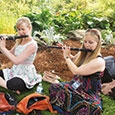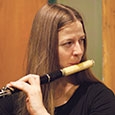
Flutists are tied, however indirectly, to a wide variety of flutes in cultures all across the world. Although folk instruments seem fundamentally different from silver flutes, wooden flutes played by traditional musicians are in fact the same as classical flutes from the time of Beethoven and Schubert. The wooden flute, often referred to as an Irish flute, is adapted from the 19th-century predecessor of the Boehm flute. When these flutes were abandoned by classical flutists in favor of the Boehm system, they were gradually adopted by traditional music community. Today the wooden simple system flute is used by players of traditional music in Ireland, Scotland, Brittany (France), Quebec, and even Sweden. Some musicians prefer to play antique instruments, while others play contemporary flutes adapted from the patterns of historic workshops such as Rudall, Rose, and Carte.
Selecting an Instrument
When you begin the hunt for a good wooden flute, it helps to keep two things in mind. The first is that there is nothing simple about the simple system flute. Because these instruments have conical bores (as compared to the cylindrical bore of the Boehm system flute), they vary widely from maker to maker. It is worth meeting other flutists to try as many different flutes as possible. They may provide guidance on deciding how many keys to have on your flute (instruments can be keyless or have up to eight keys) as well as their views on the advantages of different types of wood. Contemporary makers include many outstanding workshops run by individuals who are passionate about their craft. They are often happy to share this dedication and expertise directly with interested customers. The second is to remember that these wooden flutes are every bit as complex as today’s silver flutes, and to budget accordingly. Buy the best possible instrument and you will be happier in the long run. As with any instrument, something that seems inexpensive at first can become costly later in terms of frustration.
Extending Technique
Playing in a traditional style offers a golden opportunity to extend your technique. The wooden flute has some possibilities that are distinct to the instrument. For example, because the fingers are in direct contact with the holes (with no keys to intercede), both subtle changes and dramatic ornaments are possible. Irish playing has its own ornamentation system that can be adapted to a silver flute but which comes much more readily on a wooden one. Grey Larsen’s book The Essential Guide to Irish Flute and Tin Whistle provides an excellent overview of this ornamentation on both wooden and silver flutes. He notes that this ornamentation is better understood as a system of articulation as individual pitches are not heard. The ornament is used to provide a rhythmic interruption to a note, thus helping to shape a phrase in a way analogous to the way classical players utilize tonguing and slurs.
For classical flute players who love the silver flute’s ability to change tone color, a wooden flute offers tremendous possibilities for shifting timbres. This can happen not only through the embouchure and air but also through alternate fingerings. Historical fingering charts from the mid to late 1800s show that multiple fingerings are available for each note. These might be selected for pitch (making a difference between Ab and G#, for example), or they might be used to shade notes. Some players today will even vary fingerings on a repeated note, playing with the changes that come between a strong and weak sound as part of their phrasing.
Sometimes extending one’s technique means not adding but rather taking away. Irish playing has a strict moratorium on vibrato and tonguing. A straight, strong sound is preferred, with finger vibrato sometimes used in the playing of slow airs. Even if the sheet music indicates no slurs, notes are never individually tongued. Phrases may be shaped through the use of glottal stops or accenting certain notes or beats. This accenting is called the swing and is essential to an authentic sound. Interestingly, classical flutists can adapt the mechanism of their vibrato technique to create this rhythmic pulse. This is a wonderful example of how classical training can pave the way to quick learning, as long as flutists exercise options as choices and do not merely play by habit.
Hand position also varies. The fingers of the right hand are kept flat, both to facilitate ornaments and to cover the larger holes more readily. Playing with curved fingers and using the fingertips, as in classical playing, is sure to get in the way. The left hand’s role in holding the flute changes as well. Some traditional players use what is called a piper’s grip, in which the left hand thumb comes around to the front of the flute to push on the space usually occupied by a classical player’s pointer finger knuckle. This feels dramatically different, and yet is worth trying out. Once mastered, this position allows considerable freedom in the use of the first finger for ornamentation techniques. Those who retain the classical left hand position will find that the thumb is not free to move and is actually holding up the flute. Rather than indicating a personal failing of the flutist’s posture, this happens because the wooden flute has a different center of balance than the silver flute. This is a good example of how what seems familiar might actually be foreign. It is a good idea to take it slowly at first so that the body has time to internalize these new mechanics without becoming injured.
Learning by Ear
Traditional music is passed down from musician to musician, and is almost always learned by ear. While there are volumes of tunes that have been written down, it is important to understand the nature of these collections. The way a tune is written represents the way one person played that tune on a particular occasion. In a tradition where variations are part of the practice, that music would look different if the transcriber chose the second or third time through. Additionally, notation systems do not exist for transcribing most ornaments and accents. A number of ideas have been proposed, and knowing how to read them might mean understanding what is intended rather than what classically trained eyes will see. For example, what is written as an eighth-note triplet might be intended to be played as two sixteenths and an eighth. Finally, there is no Urtext version of a tune. It is not at all uncommon to find tunes in which one region of a country tends to play an F# while another plays an E – and they are both considered right. When all is said and done, finding sheet music might feel like a shortcut, but it can sometimes be the long way around.
For these reasons, finding a good teacher is essential; as with classical music, learning will happen faster when it happens directly with an experienced musician who can serve as a guide. Traditional musicians teach tunes directly, will be able to put them in their context, and can suggest variations and demonstrate ornaments that are well placed and represent a solid style. In both group classes and private lessons, teachers usually play a few notes and ask students to repeat them back. These notes are not randomly selected bits, but rather correspond with the internal phrasing of the tune. Traditional phrasing does not emphasize long, arching phrases, but rather shorter snippets that receive their own emphasis as they are strung together.
For those who are not used to it, learning by ear can feel maddeningly slow at first. Thankfully, many musicians find the learning curve happens quickly after initial breakthroughs are made. It is not only permissible but generally expected to bring a recording device to lessons to take home a version for practice. Computer apps like Capo and The Amazing Slow Downer offer the ability to slow down an mp3 while keeping the pitch constant. It is possible to put a difficult section on loop, making it easier to find pitches. This is good for musicians who feel self-conscious in the first stages of learning to play by ear. It can be hard to realize that one might be able to play an exceptionally difficult concerto but cannot match the first three notes of a seemingly simple jig. In this, flutists should enjoy the luxury of not having to know all the answers and celebrate the joy of entering a beginner’s mindset, all the while watching the development of new abilities.
Listen Widely
To support both learning by ear and developing one’s own robust style, it is essential to listen to as many traditional musicians as possible – whether through CDs, YouTube videos, concerts, or meeting them in person at festivals and sessions. Finding multiple recordings of the same tune will help to give a wider view of the variety of styles and settings that are possible. Just as there is no Urtext version of a written tune, there is no authoritative version of a performed tune. Multiple styles are considered equally correct, originally developing in geographically defined pockets when travel was uncommon and recordings were scarce. Today there is a dynamic cross-fertilization of styles that happens through experiences shared across county and country lines.
Connect with the Community
One of the joys of stepping into a new musical style is the opportunity to connect with a different group of musicians. The traditional music community is especially rich this way, with a worldwide community that is spread across the globe.
A first step to connecting with the local community is to search for a session or informal get-together in which musicians play with each other. While these often happen in a public setting such as a pub, the musicians are playing for each other rather than for an audience. Although it may appear on the surface as though the music is happening organically, there are unspoken customs that underlie a session. Learning about session etiquette before attending your first one is an essential key to receiving a warm welcome.
Those who live far away from community centers are able to access resources online, from discussion boards to online lessons. These flutists can connect directly with local communities while travelling (finding a local session is often a great way to relax after attending a conference), and especially by taking part in one of the many summer festivals that bring together musicians from diverse places.
When flutists connect with others, they enjoy two advantages: first, as tunes are passed down directly from musician to musician, the tradition itself is tightly tied to the community. Meeting individuals who can help guide your learning is just as essential in the traditional music world as it is in classical music; after all, who could imagine learning to play Syrinx well simply by watching videos on YouTube? Likewise, think of the many good friendships that are developed by playing chamber music together. A second advantage of connecting with the traditional community is that these new friendships might include musicians whose playing inspires your own.
Respect the Tradition
It is unfortunate that traditional music often has a reputation of being simple; as you learns about the intricacies of tunes and styles, the more we see how truly complex it is. As with any new skill, stepping out of your comfort zone and suspending judgments is key to making quick progress. For example, Swedish music regularly makes use of a pitch between Fn and F#. Upon hearing this unusual pitch, one response might be to correct the intonation. This unfortunately implies that beginners who come from a classical background have the authority to improve the tradition – an impression most would be horrified to give off, and which will certainly damage their ability to connect with other musicians. A better choice would be to listen with open ears, notice the pitch seems unusual, and then accept the challenge of learning to place the note accurately: right between Fn and F#.
Finding Your Own Sound
In biology, scientists tell us that there is exceptional diversity in the places where two ecosystems converge. This edge theory is true in music as well. When we stand at the edge between classical and traditional music, creativity can flourish. Diving into a traditional world, we can strive to extend technique and learn new sounds and ways of playing. That might in turn cross-fertilize performance of other styles of music. For example, many musicians talk about the uncanny similarities between the modal chords of traditional music and that of early and Baroque music. Aiming for a strong sound, flutists might develop a dark, husky tone that opens up new colors on a silver headjoint. Or, as happened to me, the cards might all fall into place: my favorite classical composers, like Dvo˘rák and Vaughan Williams, were known for incorporating folk melodies into their music. When I discovered the richness of the traditional music world, I felt as though I had found a musical home. In short, learning a new style can help musicians find their own voices and expand their concept of musicianship. It all starts with a few steps into the unknown.






